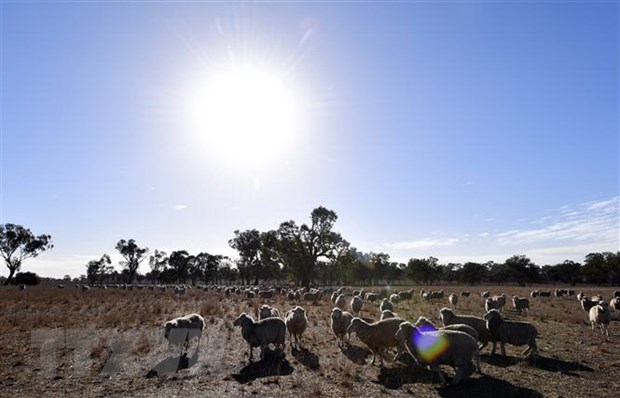
Pasture for livestock is drought due to prolonged heat in New South Wales, Australia. (Photo: AFP / VNA)
For more than 40 years, scientists have assumed that the global average temperature will increase from 1.5 to 4.5 degrees Celsius if CO2 emissions doubled compared to pre-industrial levels.
However, a comprehensive study just published on July 23 forecast that global warming could be higher.
The international study is commissioned by the World Climate Research Program and is led by Australian climate scientists and professors.
The study assessed that the global average temperature would likely increase by about 2.3-4.5 degrees Celsius if CO2 emissions in the air continued the current trend, which is double the time of pre-industrial era.
To be sure of the research results, the team combined a series of independent evidence, evaluating prehistoric and modern Earth temperature data, satellite observation results and mathematical models on the interaction in the climate system.
Professor Steven Sherwood of the University of New South Wales, one of the study authors, said: “Narrowing the range of climate sensitivity is a major challenge since the work of the National Research Council. The United States launched a range of 1.5-4.5 degrees Celsius in 1979. The same range is still cited in the most recent report of the Intergovernmental Panel on Climate Change (IPCC). " The team thinks that only 5% of the global temperature rise to below 2 degrees Celsius.
Through the study, the authors urge policymakers to take an appropriate and coordinated approach to reduce greenhouse gas emissions, as well as stop the risk of warming. Global at worst.
For more than 40 years, scientists have assumed that the global average temperature will increase from 1.5 to 4.5 degrees Celsius if CO2 emissions doubled compared to pre-industrial levels.
However, a comprehensive study just published on July 23 forecast that global warming could be higher.
The international study is commissioned by the World Climate Research Program and is led by Australian climate scientists and professors.
The study assessed that the global average temperature would likely increase by about 2.3-4.5 degrees Celsius if CO2 emissions in the air continued the current trend, which is double the time of pre-industrial era.
To be sure of the research results, the team combined a series of independent evidence, evaluating prehistoric and modern Earth temperature data, satellite observation results and mathematical models on the interaction in the climate system.
[The number of people affected by the heat will quadrupled by the end of the century]
Professor Steven Sherwood of the University of New South Wales, one of the study authors, said: “Narrowing the range of climate sensitivity is a major challenge since the work of the National Research Council. The United States launched a range of 1.5-4.5 degrees Celsius in 1979. The same range is still cited in the most recent report of the Intergovernmental Panel on Climate Change (IPCC). " The team thinks that only 5% of the global temperature rise to below 2 degrees Celsius.
Through the study, the authors urge policymakers to take an appropriate and coordinated approach to reduce greenhouse gas emissions, as well as stop the risk of warming. Global at worst.
For more than 40 years, scientists have assumed that the global average temperature will increase from 1.5 to 4.5 degrees Celsius if CO2 emissions doubled compared to pre-industrial levels.
However, a comprehensive study just published on July 23 forecast that global warming could be higher.
The international study is commissioned by the World Climate Research Program and is led by Australian climate scientists and professors.
The study assessed that the global average temperature would likely increase by about 2.3-4.5 degrees Celsius if CO2 emissions in the air continued the current trend, which is double the time of pre-industrial era.
To be sure of the research results, the team combined a series of independent evidence, evaluating prehistoric and modern Earth temperature data, satellite observation results and mathematical models on the interaction in the climate system.
[The number of people affected by the heat will quadrupled by the end of the century]
Professor Steven Sherwood of the University of New South Wales, one of the study authors, said: “Narrowing the range of climate sensitivity is a major challenge since the work of the National Research Council. The United States launched a range of 1.5-4.5 degrees Celsius in 1979. The same range is still cited in the most recent report of the Intergovernmental Panel on Climate Change (IPCC). " The team thinks that only 5% of the global temperature rise to below 2 degrees Celsius.
Through the study, the authors urge policymakers to take an appropriate and coordinated approach to reduce greenhouse gas emissions, as well as stop the risk of warming. Global at worst.